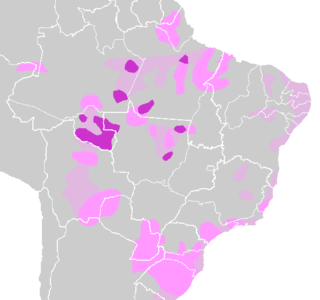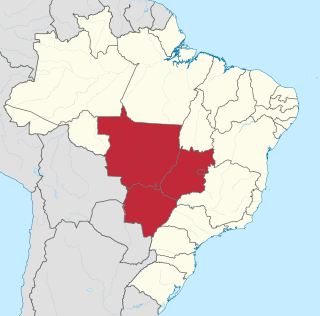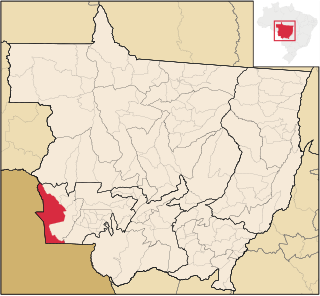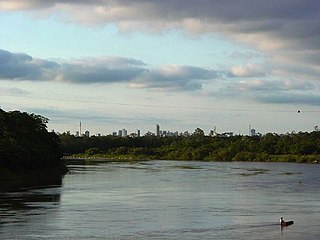
Mato Grosso is one of the states of Brazil, the third largest by area, located in the Central-West region. The state has 1.66% of the Brazilian population and is responsible for 1.9% of the Brazilian GDP.

Mato Grosso do Sul is one of the Midwestern states of Brazil. Neighboring Brazilian states are Mato Grosso, Goiás, Minas Gerais, São Paulo and Paraná. It also borders the countries of Paraguay, to the southwest, and Bolivia, to the west. The economy of the state is largely based on agriculture and cattle-raising. Crossed in the south by the Tropic of Capricorn, Mato Grosso do Sul generally has a warm, sometimes hot, and humid climate, and is crossed by numerous tributaries of the Paraná River. The state has 1,3% of the Brazilian population and is responsible for 1,5% of the Brazilian GDP.

Tupi–Guarani is the name of the most widely distributed subfamily of the Tupian languages of South America. It includes fifty languages, including the best-known languages of the family, Guarani and Old Tupi.

The Central-West or Center-West Region of Brazil is composed of the states of Goiás, Mato Grosso and Mato Grosso do Sul; along with Distrito Federal, where Brazil's national capital, Brasília, is situated. This Region is right in the heart of Brazil, representing 18.86% of the national territory.

The Federal University of Mato Grosso do Sul, is a public university located in the state of Mato Grosso do Sul in Brazil. It has, in addition to the main campus in Campo Grande, nine campuses located in the following inland cities: Aquidauana, Chapadão do Sul, Corumbá, Coxim, Naviraí, Nova Andradina, Paranaíba, Ponta Porã e Três Lagoas.

Aripuanã is a municipality in the state of Mato Grosso in the Central-West Region of Brazil. It is located on the banks of the Aripuanã River.

Vila Bela da Santíssima Trindade is a Brazilian municipality in Mato Grosso with 16,271 (2020) inhabitants. It is located at upper Guaporé River close to the border with Bolivia. It served as the capital of the Captaincy of Mato Grosso from 1752 to 1820.

The Cuiabá River is a Brazilian river in the western state of Mato Grosso that flows in the Río de la Plata Basin. It is a tributary of the São Lourenço River.

The Nambikwaran languages are a language family of half a dozen languages, all spoken in the state of Mato Grosso in Brazil. They have traditionally been considered dialects of a single language, but at least three of them are mutually unintelligible.
The Miss Brazil 2001 pageant took place March 26, 2001. Each state and the Federal District competed for their state and went win the title of the Brazilian Crown. The winner would enter Miss Universe 2001. Miss Internacional Brazil would enter Miss International 2001. This year was the first time that Miss Brazil World was separated from the pageant for only 1 year with winner of that contest competing at Miss World 2001.

Santarém Novo is a municipality in the state of Pará in the Northern region of Brazil.

The Ofayé or Opaye language, also Ofaié-Xavante, Opaié-Shavante, forms its own branch of the Macro-Jê languages. It is spoken by only a couple of the small Ofayé people, though language revitalization efforts are underway. Grammatical descriptions have been made by the Pankararú linguist Maria das Dores de Oliveira (Pankararu), as well as by Sarah C. Gudschinsky and Jennifer E. da Silva, from the Universidade Federal do Mato Grosso do Sul.

Events in the year 1983 in Brazil.

The Rio Flor do Prado Ecological Station (Portuguese: Estação Ecológica do Rio Flor do Prado is an ecological station in Brazil. It protects an area of Amazon rainforest and is administered the state of Mato Grosso.

The Piquirí River is a river of Mato Grosso state in western Brazil. It is a tributary of the São Lourenço River.

The Culuene Biological Reserve is a biological reserve in the state of Mato Grosso, Brazil. It protects an area of cerrado forest in contact with seasonal deciduous forest on the left (west) bank of the Culuene River.














